
Helpful lister chart from Blister Prevention in Australia; deroofed blisters? Not good, mate.
Today the AMR Aid Station heads to your feet–and running blisters, the sores we all love to hate.
Blister hurt, the tiny buggers!
Running on the beach a few weeks ago—in shoes, no less!—both of my third toes got blisters so big they looked like they were auditioning for a tiny toe production of Elephant Man.
Blisters are the most common “injury” runners suffer. It was the number one “injury” runners reported in the 2017 National Runner Survey conducted by Running USA,
“Blisters aren’t an ‘injury’!” I scoffed when I saw that. But I didn’t have a blister then, did I?

WARNING: Running on the beach during vacation may induce long-lasting post-vacation nostalgia. And blisters.
OW! WHY DO WE GET BLISTERS?
A foot blister, in podiatrist-speak, is a “small fluid-filled pocket that forms on the upper-most layer of the skin. Blisters are filled with clear fluid and can lead to blood drainage or pus if the area becomes infected.”
In the most simple terms, blisters form because of increased friction between your skin and sock or shoe, says Richard Braver, DPM, a runner and podiatrist at Active Foot and Ankle Care in New Jersey who has served on the medical boards at the Boston, New York and Chicago marathons.
Your body responds to this friction by producing fluid, which builds up beneath the skin that’s being rubbed. “As the outermost layer of skin, or epidermis, is damaged, fluid helps to protect the bottom layers of skin from further infection,” says Dr. Braver. Blisters can take up to a week to heal.
Many of us can run up to many miles during training with never even the hint of a blister, and then have one pop up during a races, especially a long one, like a half or a marathon.
Anything that intensifies rubbing between your foot, sock and shoe can start a blister, including a faster pace, poor-fitting shoes, uneven terrain like a trail (especially if you’re not used to running on trails) or the beach and foot abnormalities, such as bunions, heel spurs, and hammertoes. Heat and humidity intensify friction by causing your feet to swell.
Since moisture is a factor, races are the perfect breeding ground for blisters: You’re sweating more, sloshing through water stations and, if the weather is warm, probably pouring water over your head.

Fast Teacher Friend did a trail marathon (we never run trails) as a tune-up for an upcoming ultra and came home with a blister the size of a small moose.
SHOULD YOU POP A BLISTER?
Am I the only one who sees a blister on her toe as a beckoning to play out her inner Meredith Grey?
My dear running pal, a k a Fast Teacher Friend, did a trail marathon this weekend as a catered long run in preparation for a trail ultra in October and came home with a ginormous blister underneath her big toe. She asked, “Is it advisable to pop the blister?”
In a word: NO.
Popping a blister is absolutely the number one things doctors don’t want you to do, because of infection risk. “When the skin and the membrane of the skin are compromised by popping the blister, all of the bacteria that live on the skin normally can invade and could cause inflammation or an infection right away,” Dr. Jordan Metzl, M.D., sports medicine physician at the Hospital for Special Surgery in New York City, has explained to countless non-hearing runners.
Think about how much opportunity your feet have to come in contact with unclean surfaces, says me. Especially if you spend “free time” writing about blisters instead of cleaning the kitchen floors. Ahem.

SEE THAT DOG? How am I supposed to clean the kitchen floor, anyway?
If you are not careful, your popped blisters may become infected and make your toes hurt for up to three weeks after having suffered them as a consequence of running on the beach. Just saying.
Dr. Braver suggests covering the blister with a waterproof Bandaid or moleskin and allowing it to shrink and dry out on its own.
If you absolutely must pop a blister (me!), because you are traveling or can’t resist (me!) or because [insert whatever rationalization you want to here], Dr. Metzl says to clean the area with soap and water and clean the needle with an alcohol pad, and follow up immediately with antibiotic ointment. Clean the area regularly to prevent infection and don’t walk around barefoot.
[[READ HOW DIMITY DOES DIY TOE SURGERY,
AGAINST THE PROFESSIONAL’S ADVICE]]
BUT WE DON’T EVER WANT BLISTERS EVER. HOW CAN WE AVOID THEM?
First line of defense: The docs tell you to make sure you’re wearing the right size shoe, which is at least a whole size larger than your regular street shoe.
Running-shoe specialists say you should have at least a thumbs-nail width between the end of your big toe and the end of the toe box.
Why? Because your toes need more room to spread out and push off when you are repeatedly slapping the pavement, and all that slapping causes them to swell. If you’ve ever had to squeeze your feet into office-appropriate shoes (or worse, heels—the horror, the horror) after running, you know what we mean.
Too-small shoes may cause blisters on any part of your foot AND also under the toenails, which can lead to black toenails that fall off. Which depending on your point of view, is super gross or super BA.
Dr. Braver advises checking the lining of running shoes before you buy them to confirm that the seams are not raised, which could encourage blister formation.
Socks are another issue. Of course you’re wearing sweat-wicking socks. They should fit close to the skin (though not so tight your toes curl). Reinforced heels and toes help reduce friction.
Personal tip: The longer the run, the more your feet swell. That means, a sock that feels comfortable when you first put on your shoe may feel thickly constrictive by the end of a 3+ hour run. When I did an ultra that took nearly 7 hours, I bought running shoes an additional half-size up, and my swollen feet were grateful for the extra space.
Dr. Metzl recommends using products to keep your feet (relatively) dry, like baby or Talcum powder.
The same anti-chafing balm you use under your sports bra works well on your feet.
TIPS FROM THE TRIBE: How do YOU avoid blisters?
When we put the question to the Another Mother Runner tribe on FB, many chimed in with smart answers.
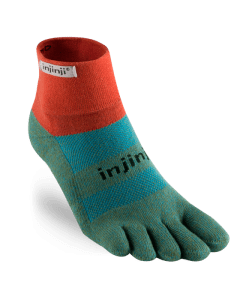
BAMRs recommend Injini socks for toe protection
Several BAMRS like Injini toe socks, which look like gloves for your feet, with individual “fingers” for each toe. “They took a little getting used to and they take a little bit longer to get on but have been worth it,” said Amy Wilson.
Emily McKay, whose toes rub together, found reusable silicon toe caps. I’ve used those for bumps between toes.
Amy Silvestri Hunter suggested taping your toes before each run. KT Tape works well for that. If you want a deep dive into the care of feet, she suggests checking out the book (and website) Fixing Your Feet.
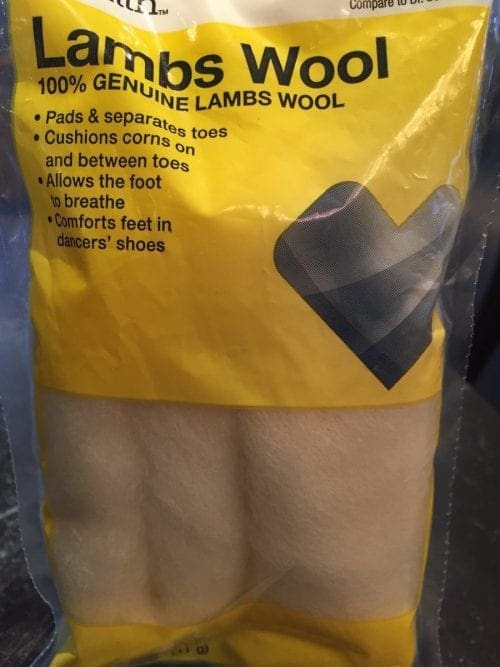
Ballet dancers—the only people on the planet with worse feet than runners—stuff lamb’s wool into pointe shoes
Gail Flores suggested lamb’s wool, which ballet dancers use in their pointe shoes. Buying a pack of lamb’s wool at CVS today launched a conversation with an intrigued cashier. “What are you using this for?” Lamb’s wool is soft, breathable, and wraps nicely around toes to cushion and separate them. (Those of us who suffer frequent ear infections put lamb’s wool in our ears so we can keep our ears dry while we shower.)
Tracy McEver uses corn cushions between toes and says you can get a pack of them for $.98 at Walmart.
Love all this wise advice! But personally I like a good blister horror story so …


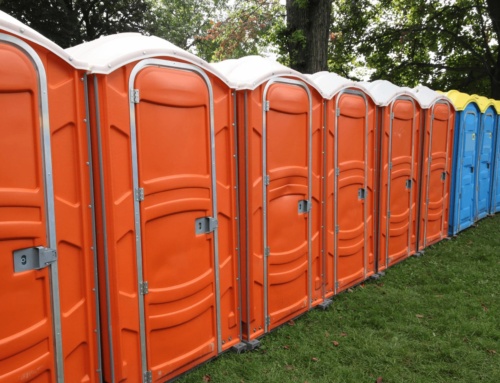
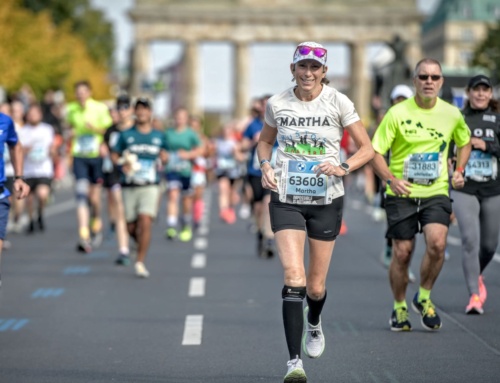
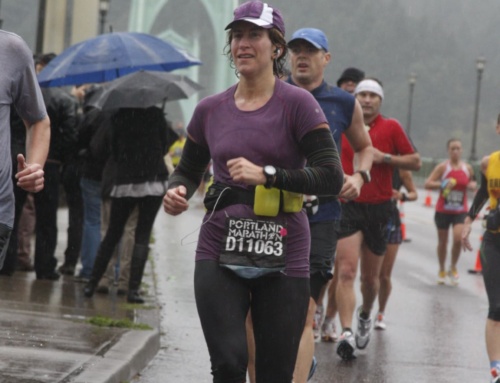

I got my very first blister from running this summer. I left it alone for a while, but it wasn’t shrinking. I tried popping it, but it would just refill. Finally, per my coach’s advice, I carefully removed the top layer — I had a long race coming up. It worked & it didn’t get infected (I used tea tree oil on it).
Hopefully not something I’ll have to deal with again! I never felt it forming at all, btw. Had no clue until I took off my shoes.
Everyone talks about shoes that are too short or tight. I got mine from shoes that really were too wide. My forefoot slid around just a hair too much and got massive blisters on the side of my foot (bunion area, though I don’t have bunions.) I love the shoes, but now I know I need to double up on socks if I am going to wear them to get a snugger fit.
Have never gotten a blister with these socks. They’ve been around forever https://www.wrightsock.com/
No blister horror stories here that are mine. I regularly coat my toes and heels with Bag Balm (bought at the Tractor Supply store) to prevent the blisters. Now, my daughter was running her first half marathon. I told her what to do but she ignored Mom because what do I know. She had a blister on the bottom of her foot by the end of the race that was the size of her fist. Next time… Bag Balm.
Horrifyingly bad blisters this weekend on the pad of my foot (not my toes, but bottom of my foot near my toes, blister forming in the area behind my second and third toes. This is a brand new location (usually it’s the tips of my toes, and the middle toe–which is a funny shape so my second toe steps on it). I’m trying to figure out whether it was the shoe/sock combination, the size of the shoes, too many miles….what? Ouch.